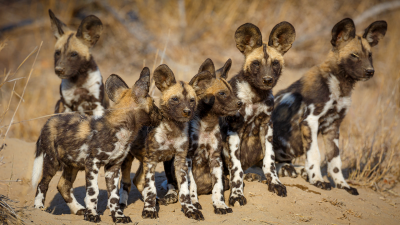
The African wild dog, also called the African painted wolf, is one of the most endangered predators in the world. It is about 60 cm tall and weighs around 20 kg. Each dog has a unique mottled coat with irregular patches of red, yellow, white and black.
This species has large rounded ‘Mickey Mouse’ ears and a white-tipped tail. They have 4 toes on their forelegs unlike 5 toes that the average dog has.
The wild dog reaches speeds of up to 70 km/h and hunts in packs. It typically preys on antelopes like Thomson’s gazelle and blue wildebeest. They may also supplement their diet with small rodents, fowl and livestock when available. These dogs have a complex and hierarchic social structure and are deeply cooperative and collaborative with each other.
For instance, they show collective responsibility towards elder members and young pups. Pack members will allow pups to have the first share of a kill and regurgitate food for older pack members if they need it. They also have a democratic system in place for decisions of whether to hunt or not to hunt. However, instead of votes, they show consent by sneezing! So, if enough dogs sneeze, the pack takes the decision to begin its next hunt!
Though they were once abundant, African wild dogs have disappeared from most of their geographic range. These days they are found in the open plains and sparse woodlands of sub-Saharan Africa with the largest populations in Botswana, Zimbabwe, Namibia, Zambia, Tanzania and Mozambique.
Causes for their declining numbers are habitat loss, hunting by other predators like lions and hyenas and diseases like rabies and distemper and the human – wild dog conflict. They are listed as ‘Endangered’ in the IUCN List.
Picture Credit : Google




